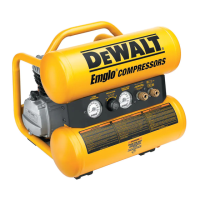15
CAUTION: Risk of unsafe operation. Compressed air from the unit
may contain wa ter condensation and oil mist. Do not spray un l-
tered air at an item that could be damaged by moisture. Some air
op er ated tools or de vic es may require ltered air. Read the in struc-
tions for the air tool ordevice.
3. Adjust regulator (D) to desired setting. See Regulator
underFeatures.
Shut-down (Fig. 1)
1 Move On/Off switch (A) is in the OFF position. NOTE: If nished
using compressor, follow Steps 2 -6.
2. Turn regulator knob (D) counterclockwise until fully closed.
Ensure regulated pressure gauge reads 0 PSI (0 kPa).
3. Remove hose andaccessory.
4. Drain the air tank, see Draining Air Tank under Maintenance.
Ensure air tank pressure gauge reads 0 PSI (0 kPa).
WARNING: Risk of bursting. Drain air tank daily. Water will con-
dense in air tank. If not drained, water will corrode and weaken the
air tank causing a risk of air tankrupture.
5. Allow the compressor to cooldown.
6. Wipe air compressor clean and store in a safe, non-freezingarea.
MAINTENANCE
The following procedures must be followed when maintenance or
service is performed on the air compressor.
1. Ensure On/Off switch is in the OFFposition.
2. Remove air compressor plug fromoutlet.
3. Drain airtank.
4. Allow air compressor to cool down before startingservice.
NOTE: All compressed air systems contain maintenance parts
(e.g., oil, filters, separators) that are periodically replaced. These
used parts may contain substances that are regulated and must
be disposed of in accordance with local, state, and federal laws
and regulations.
NOTE: Take note of the positions and locations of parts during
disassembly to make reassembly easier.
NOTE: Any service operations not included in this section should
be performed by a
factory service center or a
authorized service center.

